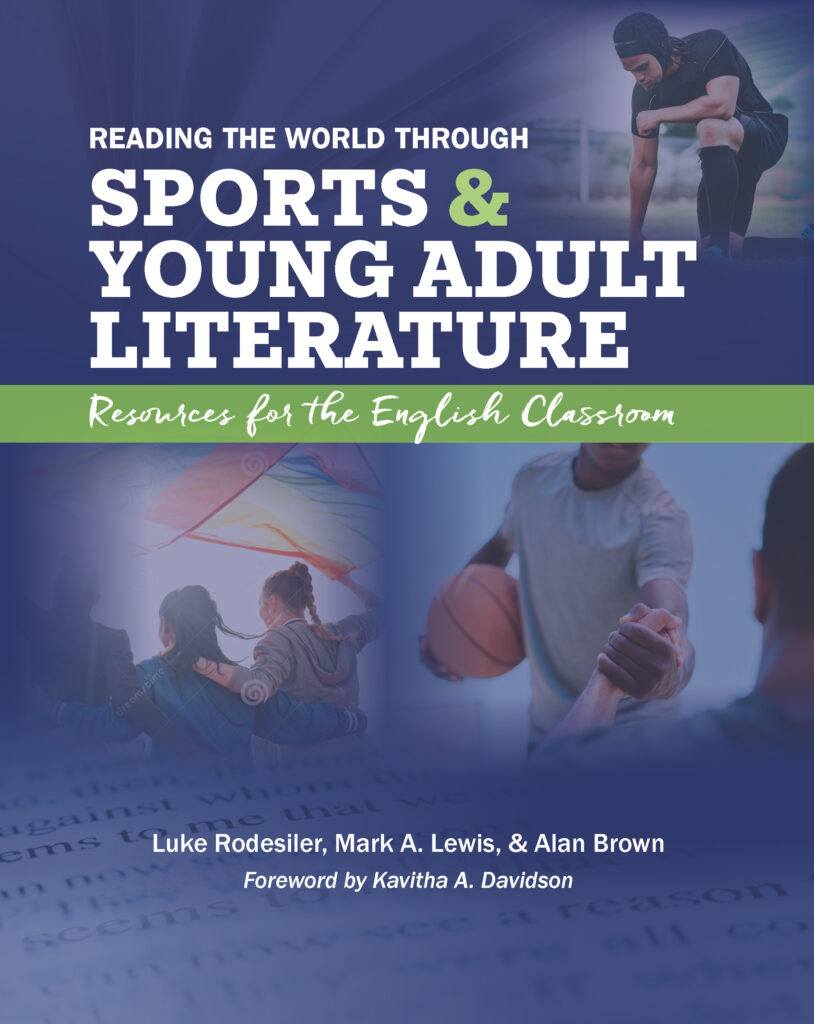“I think basketball is a container for the miraculous.”–Hanif Abdurraqib, author of There’s Always Next Year: On Basketball and Ascension
Whether you are a sports fan or not, the wide appeal of sports make them a great way to connect students to literacy. Sports are a popular vehicle for literary metaphors. There are a lot of reasons for this, but it really comes down to the fact that sporting events are in themselves stories. Most sporting events have at their center at least one story motif: the underdog, overcoming trials, perseverance, rivalries, and leadership just to name a few. Writing in the foreword of NCTE’s newest book, Reading the World through Sports and Young Adult Literature by Luke Rodesiler, Mark A. Lewis, and Alan Brown, sportswriter Kavitha A. Davidson states, “The reality is that sports have never been just about what’s happening on the field, wins and losses, or injury updates. With sports, as with literature, it’s imperative to read between the lines.”
Author Hanif Abdurraqib’s latest book, There’s Always Next Year, is structured like a basketball game, complete with a clock countdown. But the book is about so much more than basketball. Abdurraqib weaves complex themes into the book, demonstrating how intertwined sports and stories truly are. In an interview for NCTE with Antero Garcia, Hanif says, “I was never super athletic, so I couldn’t really jump very high, but I loved watching people jump high because it would seem like for a moment, they were almost destined to be there.” A simple jump becomes a metaphor for destiny and belonging. This quote is a great example of how a basic athletic action can serve as a powerful metaphor. If you missed this excellent interview, NCTE members can access a recording of it here.
Sports provide rich source material to connect with young adults. Most teens have had a connection to sports in some manner, either positive or negative. Rodesiler et al. write “Students’ knowledge of, experiences with, and critiques about sports culture, then, are assets for teaching and learning, providing valuable frames of reference when exploring sociopolitical issues of the present day.”
Sociopolitical issues in sports stories include topics like steroid use (Leverage by Joshua Cohen and Gym Candy by Carl Deuker), bullying (Gamechanger by Tommy Greenwald and Here to Stay by Sara Farizan), and tragedy and grief (The Boxer by Reinhard Kleist and The Canyon’s Edge by Dusti Bowling). They are impactful topics and can spark meaningful discussions.
Reading the World through Sports and Young Adult Literature discusses how to use stories like these in the classroom to support teaching for critical literacy and empathy in a way many students will relate to. The book provides lots of direction for educators to use the vehicle of sports to engage students in meaningful discussions, making it a valuable asset to secondary ELA teachers.
So much of sports is divisive, us versus them or winners and losers, but they are microcosms of the world we live in and can unify as well as divide. Because sports mean so much to so many, we need to focus on what really matters within them. Davidson says, “It’s critical to continue to question [sports] and particularly those in authority with the power to shape our experiences from the top down.”
For ways to bring sports into your classroom, check out NCTE’s new book: Reading the World through Sports and Young Adult Literature
NCTE members, to watch Hanif Abdurraqib’s interview, click here.
ReadWriteThink.org Resources on Sports and Literature:
Podcast: Text Messages—Recommendations for Adolescent Readers
Books about sports can capture the excitement of the big game, but the best sports books do something more. They depict teens living complex lives where involvement in sports is part of a larger coming of age process. Tune in to hear about works of sports fiction and nonfiction that explore issues of identity and belonging, courage and equal rights, and changes over time in American history and culture.
For Argument’s Sake: Playing “Devil’s Advocate” with Nonfiction Texts
In this lesson, students adopt the role of “devil’s advocate” to debate a series of proposals to reform professional sports. By recognizing potential weaknesses in the proposals and considering the reforms from multiple perspectives, students exercise divergent thinking to inspire debate and achieve a comprehensive understanding of the issues. Using high-interest articles from The Atlantic magazine, students annotate the texts and respond to contentions by generating counterarguments. Students then debate the proposal to eliminate high school sports by representing the interests of stakeholders at a town hall meeting.
References
Abdurraquib, Hanif. 2024. “There’s Always This Year: On Basketball and Ascension.” Interview by Antero Garcia. March 15, 2024. Video, 60:00. https://ncte.org/blog/video_library/theres-always-this-year-on-basketball-and-ascension/.
Davidson, Kavitha A. 2024. Foreword to Reading the Worlds through Sports and Young Adult Literature: Resources for the English Classroom., by Luke Rodesiler, Mark A. Lewis, and Alan Brown, 5–7. Champaign, IL: National Council of Teachers of English.
Rodesiler, Luke, Mark A. Lewis, and Alan Brown. 2024. Reading the World through Sports and Young Adult Literature: Resources for the English Classroom. Champaign, IL: National Council of Teachers of English.

